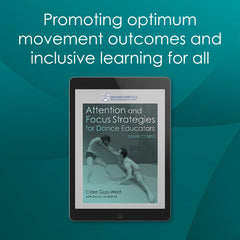Inspiring Creativity - External Focus of Attention in Practice
By Clare Guss-West, MA, and David Leventhal, BA
FEBRUARY 2023
In conversation with us, dance educators often bemoan the challenge of creating their own repertoire of diverse EFA ideas appropriate for different learners and skills levels. However, in an interactive exchange of a recent webinar we facilitated, participants suggested a plethora of inspirational EFA feedback. These ideas enhanced aspects of our performance and our artistry for our short dance excerpts based on a poem The Clearing by Morgan Farley.
Imagine the range of possible EFA types as a spectrum ranging from more tangible to less tangible foci:
REAL - DANCE CONTENT - SENSORY - IMAGINARY
For example:
REAL - environment, clothes, partners.
DANCE CONTENT: story, directions, geometric shapes, quality, musicality.
SENSORY: sounds, breath, voice, touch, textures.
IMAGINARY: metaphorical imagery, visualization, mental rehearsal.
David invited participants to propose EFA feedback to improve his jump height and rhythm using either Dance Content (story/shapes/geometry) or Imaginary EFA. Here are a few highlights:
REAL
Feel your pants pull you up into the air
DANCE CONTENT
Draw a line to the sky - reach to the mountains on a diagonal
Focus on the four directions
Weightlessness
Reaching up to Rapunzel and Romeo to Juliet

Educators can choose imagery for the potential information it implies - information relating to the form, the dynamic and the quality of the desired movement. One participant commented on the change to movement quality and effect when David used IMAGINARY EFA prompts: trampoline jump and then, sending a dove off. The trampoline produced an immediate focus on power and athletic jump height, whereas the image of a dove’s release prompted shifts in upper body expression and intention, clear eye focus and a delicate weightlessness. Tangible imagery based on story and movement form are perhaps more appropriate for younger students, such as picking a cat out of a tree or peeking over the fence. For more advanced students, the sensory information and expression implied in sending a dove off are appropriate.
For the excerpt I dance, subtle differences to movement effect were provoked by proposed images. Initial imagery related to movement shape and form, the letters "U" or "O" of the alphabet, that consolidate the clarity of a movement–embed learning and improve retention, particularly for younger students learning their alphabet. Images such as bird wings implied information about the breadth of the form. However, a similar cue, soaring bird, brought more subtle sensory information. While performing, I could imagine the uplift from circling warm air vortexes and the sound of soaring. This added a qualitative focus to the breath, and to the continuity of the movement. For the same opening arm movement, the cue sunrise provided information about the form of the movement while completely changing the rhythm and the intensity of the opening.
Enhancing our palette of EFA ideas and prompts, and mining the full possibilities of the EFA spectrum, enables us as dance educators to harness the power of nuance, and to promote the artistic process of our dancers, at any skills level. By brainstorming together, we moved beyond individual comfort zones and collaboratively expanded our EFA repertoires. Rather than bemoaning the challenges, we can seek opportunities–through exchange, collaboration, conversation, and our own re-engagement of an imaginative view of the world surrounding us–to enhance the range of language that will guide, inspire and empower our students.
To learn more from Clare Guss-West and David Leventhal, check out Attention and Focus Strategies for Dance Educators Online Course.

Latest Posts
- Incorporating Musical Learning into Beginning Dance Classes - Part 2
- Incorporating musical learning into beginning dance classes
- Celebrating the dance contributions of women dancers
- Review of Essentials of Dance Psychology by Dr. Jenny Seham
- Inspiring Creativity - External Focus of Attention in Practice
- Review of Music Education for Dancers Online Course




